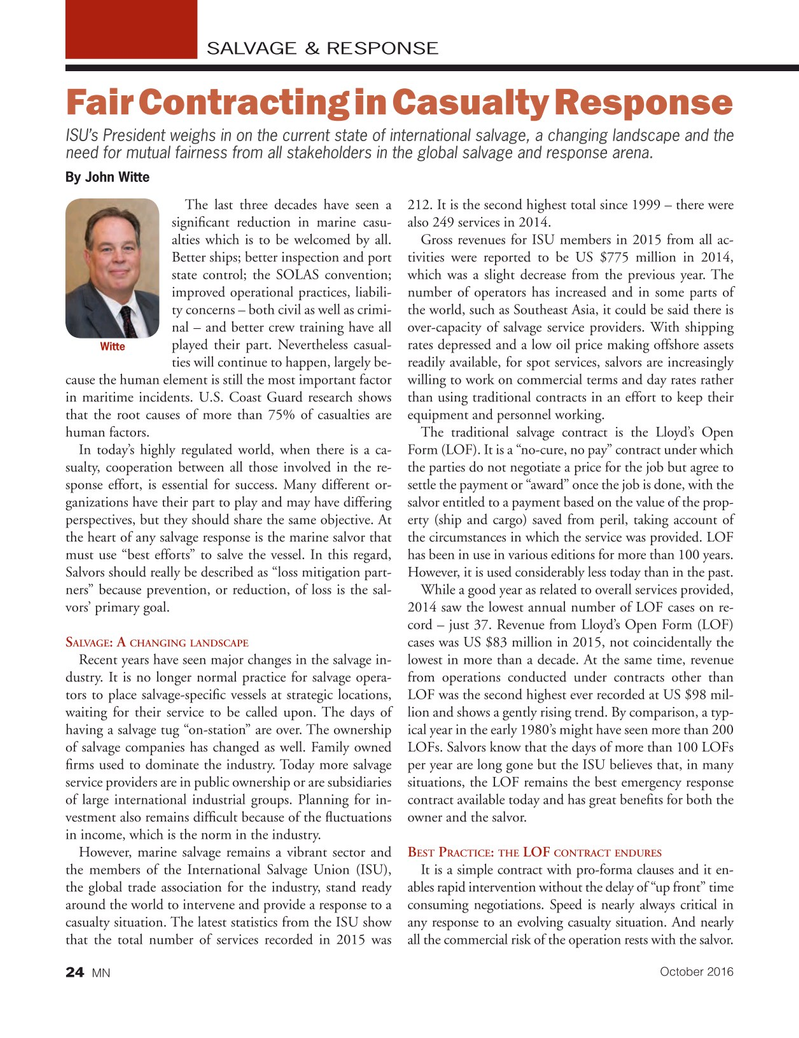
Page 24: of Marine News Magazine (October 2016)
Salvage & Spill Response
Read this page in Pdf, Flash or Html5 edition of October 2016 Marine News Magazine
SALVAGE & RESPONSE
Fair Contracting in Casualty Response
ISU’s President weighs in on the current state of international salvage, a changing landscape and the need for mutual fairness from all stakeholders in the global salvage and response arena.
By John Witte
The last three decades have seen a 212. It is the second highest total since 1999 – there were signi? cant reduction in marine casu- also 249 services in 2014. alties which is to be welcomed by all. Gross revenues for ISU members in 2015 from all ac-
Better ships; better inspection and port tivities were reported to be US $775 million in 2014, state control; the SOLAS convention; which was a slight decrease from the previous year. The improved operational practices, liabili- number of operators has increased and in some parts of ty concerns – both civil as well as crimi- the world, such as Southeast Asia, it could be said there is nal – and better crew training have all over-capacity of salvage service providers. With shipping played their part. Nevertheless casual- rates depressed and a low oil price making offshore assets
Witte ties will continue to happen, largely be- readily available, for spot services, salvors are increasingly cause the human element is still the most important factor willing to work on commercial terms and day rates rather in maritime incidents. U.S. Coast Guard research shows than using traditional contracts in an effort to keep their that the root causes of more than 75% of casualties are equipment and personnel working. human factors. The traditional salvage contract is the Lloyd’s Open
In today’s highly regulated world, when there is a ca- Form (LOF). It is a “no-cure, no pay” contract under which sualty, cooperation between all those involved in the re- the parties do not negotiate a price for the job but agree to sponse effort, is essential for success. Many different or- settle the payment or “award” once the job is done, with the ganizations have their part to play and may have differing salvor entitled to a payment based on the value of the prop- perspectives, but they should share the same objective. At erty (ship and cargo) saved from peril, taking account of the heart of any salvage response is the marine salvor that the circumstances in which the service was provided. LOF must use “best efforts” to salve the vessel. In this regard, has been in use in various editions for more than 100 years.
Salvors should really be described as “loss mitigation part- However, it is used considerably less today than in the past. ners” because prevention, or reduction, of loss is the sal- While a good year as related to overall services provided, vors’ primary goal. 2014 saw the lowest annual number of LOF cases on re- cord – just 37. Revenue from Lloyd’s Open Form (LOF)
ALVAGE CHANGING LANDSCAPE
S : A cases was US $83 million in 2015, not coincidentally the
Recent years have seen major changes in the salvage in- lowest in more than a decade. At the same time, revenue dustry. It is no longer normal practice for salvage opera- from operations conducted under contracts other than tors to place salvage-speci? c vessels at strategic locations, LOF was the second highest ever recorded at US $98 mil- waiting for their service to be called upon. The days of lion and shows a gently rising trend. By comparison, a typ- having a salvage tug “on-station” are over. The ownership ical year in the early 1980’s might have seen more than 200 of salvage companies has changed as well. Family owned LOFs. Salvors know that the days of more than 100 LOFs ? rms used to dominate the industry. Today more salvage per year are long gone but the ISU believes that, in many service providers are in public ownership or are subsidiaries situations, the LOF remains the best emergency response of large international industrial groups. Planning for in- contract available today and has great bene? ts for both the vestment also remains dif? cult because of the ? uctuations owner and the salvor. in income, which is the norm in the industry.
However, marine salvage remains a vibrant sector and B P : LOF
EST RACTICE THE CONTRACT ENDURES the members of the International Salvage Union (ISU), It is a simple contract with pro-forma clauses and it en- the global trade association for the industry, stand ready ables rapid intervention without the delay of “up front” time around the world to intervene and provide a response to a consuming negotiations. Speed is nearly always critical in casualty situation. The latest statistics from the ISU show any response to an evolving casualty situation. And nearly that the total number of services recorded in 2015 was all the commercial risk of the operation rests with the salvor.
October 2016 24
MN
MN Oct16 Layout 18-31.indd 24 9/21/2016 3:18:20 PM

 23
23

 25
25
